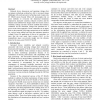Free Online Productivity Tools
i2Speak
i2Symbol
i2OCR
iTex2Img
iWeb2Print
iWeb2Shot
i2Type
iPdf2Split
iPdf2Merge
i2Bopomofo
i2Arabic
i2Style
i2Image
i2PDF
iLatex2Rtf
Sci2ools
ISQED
2010
IEEE
2010
IEEE
Limits of bias based assist methods in nano-scale 6T SRAM
Reduced device dimensions and operating voltages that accompany technology scaling have led to increased design challenges with each successive technology node. Large scale 6T SRAM arrays beyond 65nm will increasingly rely on assist methods to overcome the functional limitations imposed by increased variation, reduced overdrive and the inherent read stability/write margin trade off. Factors such as reliability, leakage and data retention establish the boundary conditions for the maximum voltage bias permitted for a given circuit assist approach. These constraints set an upper limit on the potential yield improvement that can be obtained for a given assist method and limit the minimum operation voltage (Vmin). By application of this set of constraints, we show that the read assist limit contour (ALC) in the margin/delay space can provide insight into the ultimate limits for the nano-scale CMOS 6T SRAM.
Cmos 6t Sram | Hardware | ISQED 2010 | Scale 6t Sram | Voltage |
| Added | 28 Jan 2011 |
| Updated | 28 Jan 2011 |
| Type | Journal |
| Year | 2010 |
| Where | ISQED |
| Authors | Randy W. Mann, Satyanand Nalam, Jiajing Wang, Benton H. Calhoun |
Comments (0)

